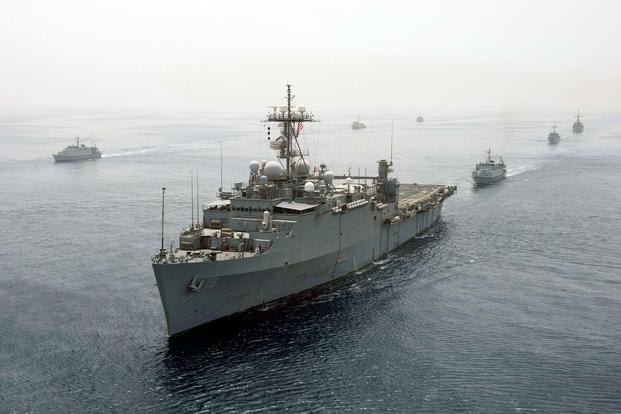A ship that was given a five-year reprieve from retirement in order to test out a new concept for the Navy finally returned home today for the last time.
The USS Ponce, born an Austin-class amphibious transport dock and remade into an afloat forward staging base in 2012, pulled into homeport in Norfolk, Virginia, today, ending a five-year deployment to the Middle East. The ship is set to be retired after 46 years in service later this year.
The Ponce, one of the oldest ships in the entire Navy fleet, had a full career before being tapped for a new mission. She was tasked with patrolling off the shore of Beirut, Lebanon in early 1984, months after a terrorist bombing of a Marine barracks in Beirut in October 1983 killed 241 U.S. troops and 58 French peacekeepers.
The ship supported Operations Desert Shield and Desert Storm from the Mediterranean during a 1991 deployment, and in 2003 was tasked with carrying Marines from Camp Lejeune, North Carolina to support the invasion of Iraq.
Related Content:
- Military.com Equipment Guide: Ships and Submarines
- Video: USS Lewis B. Puller Commissioning
- USS Ponce Assists Bahraini Fishermen
In late 2011, at the age of 40, the ship returned to port to be decommissioned. But plans changed when U.S. Central Command asked for an interim afloat forward staging base, a new class of seabasing ship that had yet to enter service. The ship's mission would be to conduct mine countermeasures, said Jim Strock, an independent consultant who previously directed the Marine Corps' Seabasing Integration Division.
"What the Ponce did, it filled an immediate compelling operational need that was in the Straits of Hormuz to ensure freedom of navigation in that area of the world," Strock told Military.com. "Iran was rattling its saber back in 2012. The United States said, 'we've got a handful of minesweepers over there, but we need a platform that will support aviation capabilities.'"
The Navy spent between $60 and $70 million to modify the Ponce for the mission, Strock said. It was equipped with Navy MH-53 minesweeping helicopters and a hybrid civilian-military crew and deployed to the Middle East in 2012.
But while there, planners realized the ship could be instrumental for experimentation as well, testing out new concepts and equipment to inform development of new seabasing platforms that were soon to enter the fleet.
"The Ponce was a test bench," Strock said. "It turned into a laboratory; it gave us other ways to explore sea-based capabilities on an effectively non-traditional platform. They were able to leverage that platform and capture lessons learned."
Perhaps most notably, the Ponce gave the Navy a platform from which to test a prototype laser weapons system, known as LaWS, designed to defend against small vessels, aircraft, and unmanned aerial vehicles. LaWs was deployed aboard the Ponce in August 2014 for testing; it would remain aboard the ship for the duration of its time in the Middle East.
Meanwhile, the Navy was beginning to acquire purpose-built seabasing vessels, beginning with the Expeditionary Transfer Dock Montford Point in 2013. The Lewis B. Puller, the Navy's first Expeditionary Mobile Base, was commissioned in August in Bahrain as a replacement for the Ponce in the Middle East.
Currently, there are five ESB/ESDs delivered to the Navy or under construction; more are called for in the Navy's future force structure assessment. Mission sets for the ships envisioned by the Marine Corps and the Navy include special operations, humanitarian assistance and disaster relief, and other missions typically undertaken by traditional amphibious ships. And the Ponce played a role in developing the concept, Strock said.
"It was a success story," he said. "It demonstrated very quick innovation and adaptation by the Navy and the [special operations forces] community to repurpose a platform to meet a compelling operational need."
-- Hope Hodge Seck can be reached at hope.seck@military.com. Follow her on Twitter at @HopeSeck.































